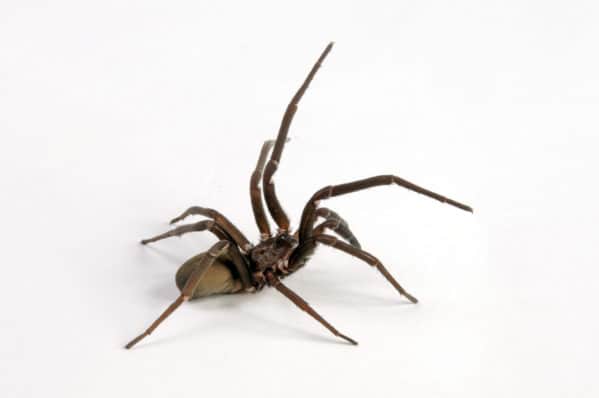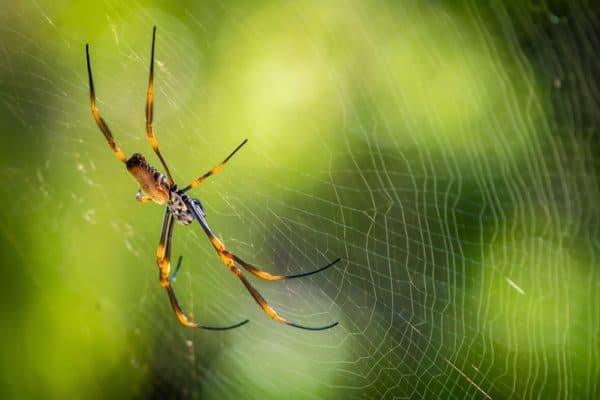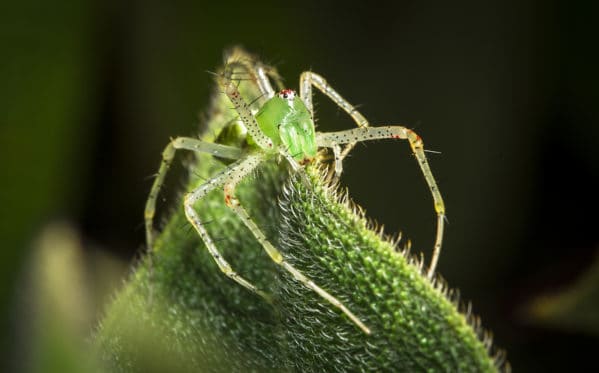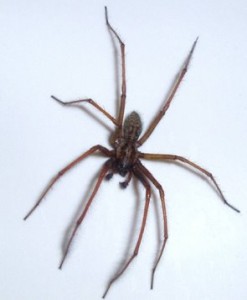READY TO GET STARTED?
REQUEST A FREE ESTIMATE
Fill out the form below or call (888) 466-7849 for a free, no-obligation estimate.

In the southern states, there are many species of spiders found and there is a good chance you’ve seen some of them. Many spiders make themselves at home in our yards, gardens, flower beds, and inside our homes. But as the weather gets cooler, you’re bound to see more spiders come inside to seek shelter from the cooler weather. Here are a few common spiders that may invade your home when the temperatures drop.
A house spider is a common name given to spiders that are primarily found inside your house. They vary in color, but most are yellow to brown with elongated abdomens. They can usually be found in ceiling corners, under furniture, and inside closets, basements, garages, and crawl spaces. When outdoors, they are often found in windows, under eaves, and near light sources.
They can be a nuisance to have but are not a threat to humans. Because of the low humidity in newer homes, house spiders are becoming less common in houses and more likely to be found in garages, sheds, barns, and warehouses.
A brown recluse spider is light to dark brown, with a signature dark brown violin shape on its back. They are commonly found outdoors in debris and woodpiles but can be found indoors usually underneath furniture, inside storage bins, and in dark recesses like baseboards. The brown recluse can also be found hiding out in closets, attics, and crawl spaces.
This spider species is one you should look out for as its bite is painful. If cornered, they will bite, leaving an ulcerating sore that must be treated by a medical professional immediately.
Wolf spiders are typically dark brown with pale markings or stripes. Their legs are long and spiny, and most have hair on their bodies. If found indoors, they are typically on the floor, especially along walls and under furniture. If found outdoors, they are usually under leaves, woodpiles, yard debris, and stones.
They can bite, but it is very rare for them to do so; even if they do it doesn’t pose a significant threat to humans. They are unique in that they don’t catch their prey in webs but will chase them down using their speed.
One of the most easily identifiable spiders in the US, these shiny, black spiders are one of the most fearsome out there. Most can identify them by their prominent red hourglass shape on their back. Black widow spiders are commonly found around woodpiles and can easily access your home by hitching a ride on your firewood. They are also found in garages, eaves, empty boxes, and even shoes that are stored away.
Females are more aggressive than males and will bite. They can be extremely harmful to humans and their bite should be taken seriously. Symptoms from a bite include fever, elevated blood pressure, nausea, and sweats. It should be treated immediately to stop any further neurological damage.
Spiders are more common in the fall and winter as they make their way indoors, so be on the lookout for these spiders once the temperature begins to drop. If you suspect a spider problem, contact your local pest control company who can help identify the type of spider you have and provide you with a thorough inspection and treatment plan that is right for you and your property.

Nothing says “Halloween” like spotting a few cobwebs around the house! While it’s always fun to see cobweb decorations during this time of year, it’s not as fun having to deal with them year-round. Since the temperatures have cooled off, many spiders are looking indoors to inhabit a warmer environment. It’s important to understand common types of spiders in order to provide the best treatment if they’ve infested your home.
Brown Recluse
The brown recluse spider is light to dark brown, with a signature brown violin shape on its backs. If threatened, these spiders will bite, which can be painful and leave an open sore. If bitten, some can experience fever, restlessness, and difficulty sleeping. Brown recluse spiders can be found in debris and woodpiles. If they’ve snuck inside your home, they can often be found under furniture, inside storage items, in baseboards, closets, and crawlspaces.
Wolf Spider
Wolf spiders are dark brown with paler stripes or markings and long, spiny legs. These spiders are large and hairy across their bodies. While these spiders will bite, it’s rare that they do and are not a significant threat to humans. Inside homes, wolf spiders tend to stay near or on the floor, especially along walls and under furniture where they chase their prey instead of capturing them in their webs. If outside, they like to inhabit firewood piles, leaves, yard debris, and stones.
Common House Spider
House spiders can vary in color but are usually yellow to brown with elongated abdomens. Although not a threat to humans, they are a nuisance to have in the home as they can produce and leave behind webs throughout the house. They can often be found in ceiling corners, under furniture, and inside closets, basements, garages, and crawlspaces. If outside, you will commonly find them spinning webs around windows, under eaves, and near light sources that attract food.
By recognizing each spider species and knowing where they most often inhabit, you can utilize the correct preventative measures to eliminate the chance of an infestation. Check out some of these easy do-it-yourself spider prevention tips:

The climate of Georgia (and the southern United States in general) provide the ideal environment for several species of spiders. The humidity and subtropical conditions provide just the right setting for these pests to thrive. Almost all species of spiders found in the United States pose no threat to humans. In fact, of the 38 known species of spiders in Georgia, only 2 are harmful to humans. Here are 10 of the most common spiders found in Georgia and the threat they may pose to you and your family.

Black widow spiders are black and shiny in color with a prominent red hourglass shape on their back. They are most often found around woodpiles and can easily access your home by hitching a ride inside on your firewood. They are also found in common places around your home where they can be undisturbed like eaves, empty boxes, and even shoes that are stored away and never worn. Black widows can be harmful to humans if bitten. While males rarely bite, females have been known to be aggressive especially when they are guarding their eggs. Black widow bite symptoms include fever, elevated blood pressure, nausea, and sweats. Death is uncommon after a black widow bite, especially if treatment is received quickly. In fact, there has not been a black widow related death in the United States in over 10 years.

Brown recluse spiders are light to dark brown in color (hence their name) with a signature dark brown violin shape on their backs. They are commonly found outdoors in debris and woodpiles. If they are found indoors, they are usually found underneath furniture, inside storage bins, and in dark recesses like baseboards. They are often found hiding out in closets, attics, and crawlspaces. Brown recluse spiders will bite when on the defensive. These bites are very painful and often leave an open, ulcerating sore that must be treated by a medical professional. Other symptoms include fever, restlessness, and difficulty sleeping.

House spiders vary in color but most are yellow to brown in color with elongated abdomens. They are most often found inside homes (hence their name) usually in ceiling corners, under furniture, and inside closets, basements, garages, and crawlspaces. When outdoors, they are often found around windows, under eaves, and near light sources. While they can be a nuisance to have in your home, they don’t pose any threat to humans. Because of the low humidity and fewer insects in modern homes, house spiders are becoming less common in houses and more likely to be found in garages, sheds, barns, and warehouses.

Wolf spiders are typically dark brown in color with pale markings or stripes. Their legs are long and spiny and most have hair on their bodies. When indoors, wolf spiders typically stay on or near the floor, especially along walls and under furniture. They often come inside on firewood. When found outside they are usually found under firewood piles, leaves, yard debris, and stones and will often hide in these places during the day. While wolf spiders can bite, these incidents are rare and they don’t pose a significant threat to humans. Wolf spiders are unique in that they don’t capture their prey in webs but rather by chasing them down using their speed.

Crevice spiders have similar shapes and coloring as brown recluse spiders and are, in fact, often mistaken for them. While they do have the same light to dark brown coloring and similar body shape, they do not have the signature violin-shaped markings that the brown recluse has. They are often found in corners and crevices which is where their name comes from, typically located in ceiling corners, along baseboards, and in window frames. They can be beneficial to homeowners as they eat common household pests like flies, roaches, beetles, and wasps. While they can bite if threatened, this is very rare and they do not pose a significant threat to humans.

The yellow garden spider is a large, black and yellow spider that is known for spinning large circular webs. Females are black with bright yellow patches on their abdomens. Males are smaller with less yellow coloring on their abdomens. They are typically found outdoors in sunny areas with plants on which they can anchor their webs (hence their name). Garden spiders don’t pose a threat to humans (other than the chance of walking through their sometimes significantly large webs) but they do produce venom that is harmless to humans, but helps to immobilize prey like flies, bees, and other flying insects that are caught in the web.

Orb weaver spiders can vary in size and coloring but are often mistaken for brown recluse spiders. They are known for creating distinctive sheet webs with an escape tunnel at the rear. These webs can be up to 3 feet in diameter. Many orb weavers are brightly colored, have hairy or spiny legs and a relatively large abdomen. Orb weavers are typically nocturnal spiders and many species will build or do repair work on their webs at night. Orb weavers do not pose a threat to humans. They will bite if cornered but the bite is comparable to a bee sting.

The lynx spider is bright green in color, resembling the color of a plant leaf. They will also sometimes have orange on their legs and black dots, as well. Their legs are covered in long black spines. They are very quick in movement and are able to jump large distances to capture their prey. They are often found in open fields, especially those with tall grass surroundings. The lynx spider can be quite useful in agricultural management. They will bite if on the defensive but they do not pose a significant threat to humans.

The trapdoor spider is a large, hairy spider that can range in color from yellowish brown to reddish brown to black. They have powerful jaws and sharp fangs. Trapdoor spiders get their name from the burrows they construct with a cork-like trapdoor made of soil, vegetation and silk. They spend most of their lives underground and usually hunt at night. Trapdoor spiders are not aggressive and, in fact, are often timid when confronted. They can bite but this is rare. They do not pose a significant threat to humans.

The hobo spider is light to medium brown in color with a down the center with an oblong abdomen. Hobo spiders build funnel webs that open at both ends with one end expanding outward into a broad, slightly curved sheet. Mating season is from June to October and the wandering of males in search of a mate brings them in to much more contact with humans than females. Therefore, male hobo spiders are responsible for more bites than females because of this increased contact with humans. Their bites, however, do not pose a significant threat to humans. Hobo spiders can be found in almost any habitat. They are commonly found in places with holes, cracks, or crevices. They are terrible climbers and are rarely found above ground level. They prefer dark, moist environments like basements, crawlspaces, and window wells.

Contrary to popular belief, Granddaddy Longlegs are not, in fact, spiders; they actually belong to a group of arachnids known as harvesters or harvestmen. The predominant feature of harvesters including the granddaddy longlegs is legs that are exceptionally long in relation to their body size. Harvesters are usually seen around harvest time – hence their name. Just in North America alone there are about 150 species of granddaddy longlegs. They use their extremely long legs to catch their prey rather than building webs. Granddaddy longlegs are not poisonous or venomous and do not pose any threat to humans.
Whether they are dangerous to humans or not, most people would prefer to keep spiders out of their homes as much as possible. The best way to prevent spiders from taking up residence in your house is to get rid of any areas where they can hide. Spiders are more common in the fall and winter as they make their way indoors in search of food and warmth. Keep your garage, attic, and basement clear and decluttered. Try not to leave shoes and clothing on the floor. Seal any cracks and crevices around your home. Consider enclosing your crawlspace and sweep down any cobwebs that appear. As always, if you suspect you have a spider problem, contact a professional pest control company who can help identify the type of spiders you have and provide you with a thorough evaluation and treatment and prevention plan.
How Much Damage Can Termites Really Cause?

Autumn is right around the corner and it brings with it cooler weather, Halloween, football, and a plethora of new pests. As the weather gets colder, pests will seek shelter, food, and warmth in our homes. Different seasons bring different pests and this time of year is no exception. Here are 7 of the most common fall pests and ways to prevent them from invading your home.

Rats, mice, and squirrels are among the most common rodents seen in the fall. They need food and warmth to survive the cold winter months. Rats are known to carry disease and can cause potential health problems for you and your family. They also get into food storage and chew through wooden supports. They build their nests in your insulation and can cause fires by chewing through electrical wires. They can fit into small gaps and holes to get into your home and bring fleas, mites, ticks, and lice with them.
Rodents can be prevented by:

Cockroaches are the most common fall pest. Cockroaches can be dangerous to your health as they are known to carry 33 different types of bacteria and can cause asthma in children. They are large, fast, and extremely resilient. They like to hide near pipes and drains and are commonly seen in kitchens and bathrooms.
Cockroaches can be prevented by:

Fleas come into your home on both pets and rodents. While they don’t transmit serious diseases to humans, their bites can be painful and irritating. Fleas can spread throughout your home quickly and can be extremely difficult to get rid of.
Fleas can be prevented by:

There are several species of ants that are common in the fall. Ants can move into the walls of your home or underneath your foundations and cause significant damage to your home. Carpenter ants can chew through the wood of your home and compromise its structure. Odorous house ants can get into and contaminate your food.
Ants can be prevented by:

Stink bugs actively seek shelter indoors from the cooler weather of fall. Stink bugs don’t transmit diseases, nor do they bite or sting. They can, however, cause damage to clothing, furniture and other fabrics with their droppings. They emit a strong odor when they are frightened, disturbed, or squashed as a defense mechanism against predators.
Stink bugs can be prevented by:

There is a significant increase in the number and variety of spiders that appear in the fall. Fall is mating season for most spiders so they are actively seeking mates before winter sets in. The most common spiders seen in the fall are house spiders, which are responsible for the cobwebs you often see in your home, wolf spiders, and hobo spiders.
Spiders can be prevented by:

Travel in the fall increases with a large number of sporting events, family gatherings, and students heading back to school and college. Bed bugs ride on clothing, suitcases, and even school bags. While they don’t spread disease, they do leave behind itchy red welts. Bed bugs are extremely difficult to control and eliminate.
Bed bugs can be prevented by:
 The house spider is a common problem that we’re seeing in homes lately. We’ve had lots of calls and concerns about the tiny little pests hanging around. The most effective way of getting rid of spiders is to prevent them from ever coming into your home. Spiders, like most insects, come into your home in search of food. By ridding your home of other insects (regularly scheduled pest maintenance) your home will be useless to the spider.
The house spider is a common problem that we’re seeing in homes lately. We’ve had lots of calls and concerns about the tiny little pests hanging around. The most effective way of getting rid of spiders is to prevent them from ever coming into your home. Spiders, like most insects, come into your home in search of food. By ridding your home of other insects (regularly scheduled pest maintenance) your home will be useless to the spider.
Ways to Prevent Spiders from coming into your home:
Again, regularly scheduled pest control from a professional pest management company will keep out the spiders and their food sources.